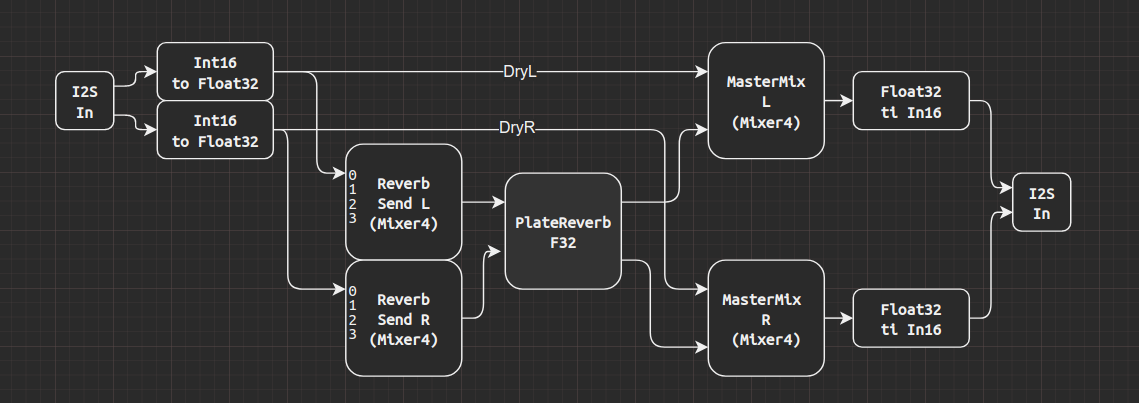Fully stereo in/out reverb component for the OpenAudio_ArduinoLibrary.
Reverb requires stereo in and out connenctions.
void size(float32_t n);
sets the reverb time. Parameter range: 0.0 to 1.0.
Example:
reverb.size(1.0f); // set the reverb time to maximum
void lowpass(float32_t n);
sets the reverb master lowpass filter. Parameter range: 0.0 to 1.0.
Example:
reverb.lowpass(0.7f); // darken the reverb sound
void hidamp(float32_t n);
sets the treble loss. Parameter range: 0.0 to 1.0.
Example:
reverb.hidamp(1.0f); // max hi band dampening results in darker sound
void lodamp(float32_t n);
sets the bass cut. Parameter range: 0.0 to 1.0.
Example:
reverb.lodamp(0.5f); // cut more bass in the reverb tail to make the sound brighter
void diffusion(float32_t n);
diffision controls the density of the reverb tail, lower values add more echo type reflections, higher values produce a lush rich reverb tail. Useful for creating a different type of reverbs: ie. with size set to 0 and diffusion to something in range 0.0f-0.3f the result will be like a ping-pong delay with room reverb.
Example:
reverb.density(0.5f); // alter the allpass coefficients to change the reverb sound
void freeze(bool state);
Cuts off the input signal and increases the reverb time coeff to 1.0, creating an infinite reverb. Combined with low diffusion settings might produce clicking, so use with caution.
Example:
reverb.freeze(true); // turn freeze on
bool freeze_tgl(void);
Toggles the freze state and retunrs the current state.
Example:
Serial.printf("Freeze = %d", reverb.freeze_tgl()); // toggle the freeze and print the current state
bool freeze_get(void);
Returns the current freeze state.
void set_bypass(bool state);
Disables (true) or enables (false) the reverb engine.
Example:
reverb.set_bypass(true); // disable the reverb (saves CPU load)
bool get_bypass(void);
Returns the current reverb bypass status.
void tgl_bypass(void);
Toggles the current reverb bypass status.
Typical application using OpenAudio_ArduinoLibrary:

by default the reverb places it's buffers into OCRAM/DMAMEM region.
Comment out the
#define REVERB_F32_USE_DMAMEM
line in the effect_platervbstereo_F32.h file to place the variables into the DCTM ram region.